- Author Matthew Elmers [email protected].
- Public 2023-12-16 21:49.
- Last modified 2025-06-01 06:23.
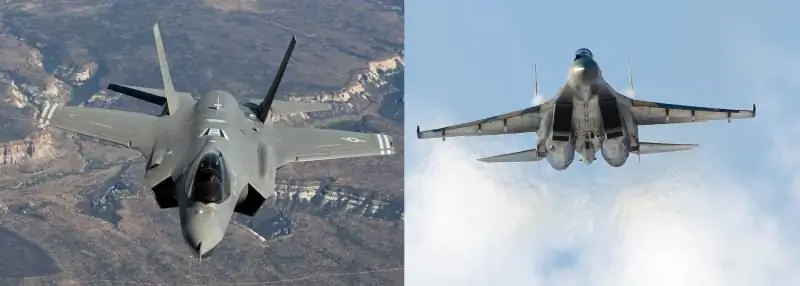
This is a continuation of the previous article. For completeness, I advise you to read the first part.
Continuing to compare the capabilities of the 4 ++ generation fighters with the 5th generation, we turn to the brightest production representatives. Naturally, these are the Su-35s and F-22s. This is not entirely fair, as I said in the first part, but still.
The Su-35s is a development of the legendary Su-27. What is the uniqueness of his ancestor, I think, everyone remembers. Until 1985, the F-15 reigned supreme in the air for nine years. But the mood overseas plummeted when the first serial Su-27s began to be adopted. A fighter with super-maneuverability, capable of reaching previously unattainable angles of attack, in 1989 for the first time publicly demonstrating the Cobra Pugachev technique, is beyond the reach of Western competitors. Naturally, his new "thirty-fifth" modification has absorbed all the advantages of the ancestor and added a number of its features, bringing the "twenty-seventh" design to the ideal.
A striking feature of the Su-35s, as well as the rest of our 4+ generation aircraft, is the deflected thrust vector. For some unknown reason, it is common only in our country. Is this element so unique that no one can duplicate it? The deflected thrust vector technology has also been tested on American fourth-generation aircraft. General Electric developed the AVEN nozzle, which was installed and tested on the F-16VISTA in 1993. Fig. # 1. Pratt Whitney developed the PYBBN (better design than GE) nozzle installed and tested on the F-15ACTIVE in 1996. Fig. No. 2. In 1998, the TVN deflectable nozzle for Eurofighter was tested. However, not a single Western aircraft of the fourth generation received OVT in the series, despite the fact that modernization and production continue to this day.
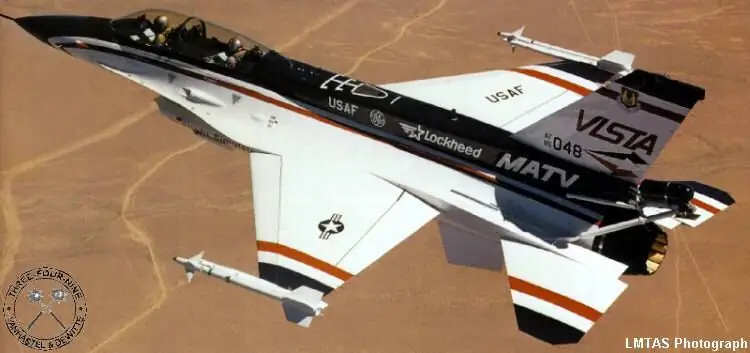
Figure # 1
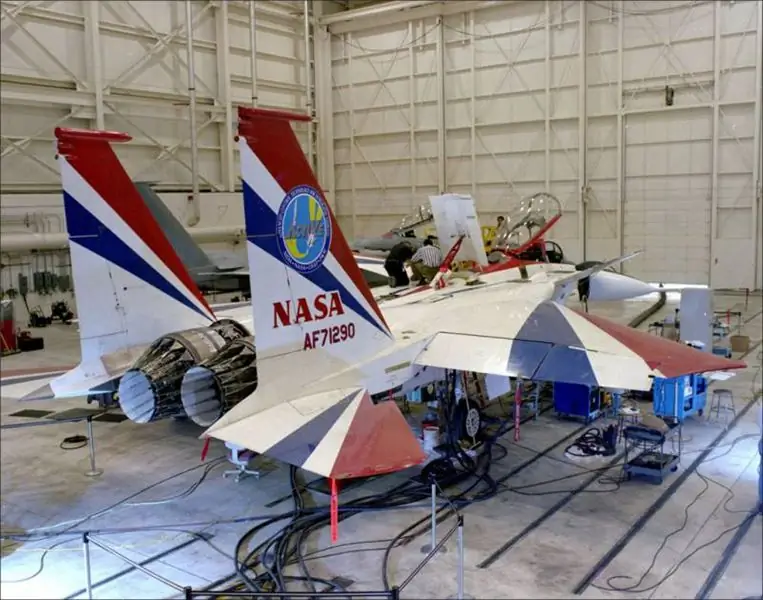
Figure # 2
Having the appropriate technologies for deflecting the thrust vector, in 1993 (AVEN) they decided not to use them on the F-22. They went the other way, creating rectangular nozzles to reduce radar and thermal signature. As a bonus, these nozzles are only deflected up and down.
What is the reason for such a dislike of the West for the deflected thrust vector? To do this, let's try to figure out what close air combat is based on, and how a deflected thrust vector can be applied in it.
The maneuverability of the aircraft is determined by the G-forces. They, in turn, are limited by the strength of the aircraft, the physiological abilities of the person and the limiting angles of attack. The thrust-to-weight ratio of the aircraft is also important. When maneuvering, the main task is to change the direction of the velocity vector or the aircraft's angular position in space as quickly as possible. That is why the key issue in maneuvering is the steady or forced turn. With a steady bend, the aircraft changes the direction of the motion vector as quickly as possible, while not losing speed. The forced turn is due to a more rapid change in the angular position of the aircraft in space, but it is accompanied by active losses of speed.
A. N. Lapchinsky, in his books about the First World War, quoted the words of several western aces pilots: the German ace Nimmelmann wrote: "I am unarmed while I am lower"; Belke said: "The main thing in air combat is vertical speed." Well, how not to remember the formula of the famous A. Pokryshkina: "Height - speed - maneuver - fire."
Having structured these statements with the previous paragraph, we can understand that speed, altitude and thrust-to-weight ratio will be decisive in air combat. These phenomena can be combined with the concept of the energy flight altitude. It is calculated according to the formula shown in Figure 3. Where He is the energy level of the aircraft, H is the flight altitude, V2 / 2g is the kinetic altitude. The change in kinetic altitude over time is called the energy rate of climb. The practical essence of the energy level lies in the possibility of its redistribution by the pilot between altitude and speed, depending on the situation. With a speed reserve, but a lack of altitude, the pilot can complete the hill, as bequeathed by Nimmelmann, and gain a tactical advantage. The pilot's ability to competently manage the available energy reserve is one of the defining factors in air combat.
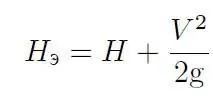
Figure №3
Now we understand that when maneuvering on established turns, the plane does not lose its energy. The aerodynamics and thrust of the engines balance the drag. During a forced turn, the aircraft energy is lost, and the duration of such maneuvers is not only limited by the minimum evolutionary speed of the aircraft, but also by the expenditure of the energy advantage.
From the formula in Figure 3, we can calculate the rate of climb parameter of the aircraft, as I said above. But now the absurdity of the data on the rate of climb, which are given in open sources for certain aircraft, is becoming clear, since it is a dynamically changing parameter that depends on altitude, flight speed and overload. But, at the same time, it is the most important component of the energy level of the aircraft. Based on the foregoing, the potential of the aircraft in terms of energy gain can be conditionally determined by its aerodynamic quality and thrust-to-weight ratio. Those. the potential of the aircraft with the worst aerodynamics can be equalized by increasing the engine thrust and vice versa.
Naturally, it is impossible to win a battle with energy alone. No less important is the aircraft's turnability characteristic. For it, the formula shown in Figure 4 is valid. It can be seen that the characteristics of the aircraft's turnability directly depend on the g-forces Ny. Accordingly, for a steady turn (without loss of energy), Nyр is important - the available or normal overload, and for a forced turn Nyпр - the maximum thrust overload. First of all, it is important that these parameters do not go beyond the boundaries of the operational overload of the New aircraft, i.e. strength limit. If this condition is met, then the most important task in the design of the aircraft will be the maximum approximation of Nyp to Nye. In simpler terms, the ability of an aircraft to perform maneuvers in a wider range without losing speed (energy). What influences Nyp? Naturally, the aerodynamics of the aircraft, the greater the aerodynamic quality, the higher the possible value of Nyр, in turn, the index of the load on the wing affects the improvement of aerodynamics. The smaller it is, the higher the aircraft's agility. Also, the thrust-to-weight ratio of the aircraft affects Nyp, the principle that we talked about above (in the energy sector) is also valid for the aircraft's turnability.

Figure №4
Simplifying the above and not yet touching on the deviation of the thrust vector, we justly note that the most important parameters for a maneuverable aircraft will be the thrust-to-weight ratio and wing loading. Their improvements can only be limited by the cost and technical capabilities of the manufacturer. In this regard, the graph presented in Figure 5 is interesting, it gives an understanding of why the F-15 until 1985 was the master of the situation.
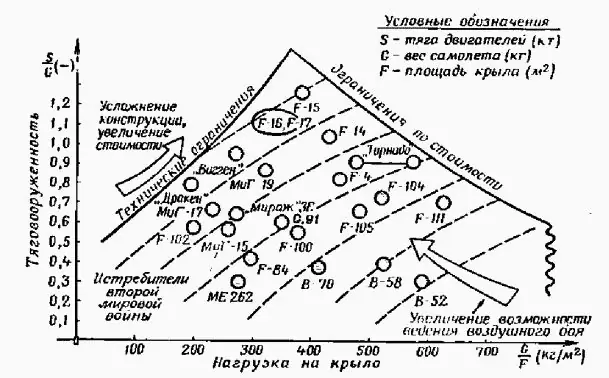
Picture No. 5
To compare the Su-35s with the F-22 in close combat, we first need to turn to their ancestors, namely the Su-27 and F-15. Let's compare the most important characteristics available to us, such as thrust-to-weight ratio and wing loading. However, the question arises, for what mass? In the Airplane Flight Manual, the normal take-off weight is calculated based on 50% of the fuel in the tanks, two medium-range missiles, two short-range missiles and the ammunition load of the cannon. But the maximum fuel mass of the Su-27 is much greater than that of the F-15 (9400 kg versus 6109 kg), therefore, the 50% reserve is different. This means that the F-15 will have a lower weight advantage in advance. To make the comparison more honest, I propose to take the mass of 50% of the Su-27 fuel as a sample, so we get two results for the Eagle. As the armament of the Su-27, we accept two R-27 missiles on the APU-470 and two R-73 missiles on the p-72-1. For the F-15C, the armament is AIM-7 on LAU-106a and AIM-9 on LAU-7D / A. For the indicated masses, we calculate the thrust-to-weight ratio and wing loading. The data are presented in the table in Figure 6.
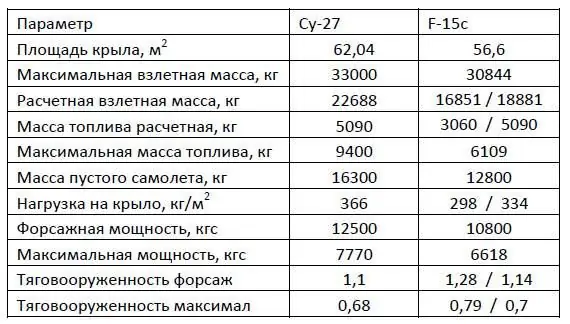
Figure 6
If we compare the F-15 with the fuel calculated for it, then the indicators are very impressive, however, if we take the fuel equal in mass to 50% of the Su-27 fuel, then the advantage is practically minimal. In the thrust-to-weight ratio, the difference is by hundredths, but in terms of the load on the wing, the F-15, nevertheless, is decently ahead. Based on the calculated data, the "Eagle" should have an advantage in close air combat. But in practice, training battles between the F-15 and Su-27, as a rule, remained with ours. Technologically, the Sukhoi Design Bureau was unable to create an aircraft as light as the competitors, it is no secret that we have always been slightly inferior in weight to avionics. However, our designers took a different path. In training competitions, no one used "Pugachev's Cobr" and did not use OVT (it did not exist yet). It was the perfect aerodynamics of the Sukhoi that gave it a significant advantage. The integral fuselage layout and aerodynamic quality in 11, 6 (for the F-15c 10) neutralized the advantage in wing loading of the F-15.
However, the Su-27's advantage was never overwhelming. In many situations and under different flight conditions, the F-15c can still compete, since most still depend on the qualifications of the pilot. This can be easily traced from the maneuverability graphs, which we will talk about below.
Returning to the comparison of the fourth generation aircraft with the fifth, we will compile a similar table with the characteristics of thrust-to-weight ratio and wing loading. Now we will take the data on the Su-35s as a basis for the amount of fuel, since the F-22 has fewer tanks (Fig. 7). Sushka's armament includes two RVV-SD missiles on the AKU-170 and two RVV-MD missiles on the P-72-1. The Raptor's armament is two AIM-120 on the LAU-142 and two AIM-9 on the LAU-141 / A. For the general picture, calculations are also given for the T-50 and F-35A. You should be skeptical about the parameters of the T-50, since they are estimates, and the manufacturer did not give official data.
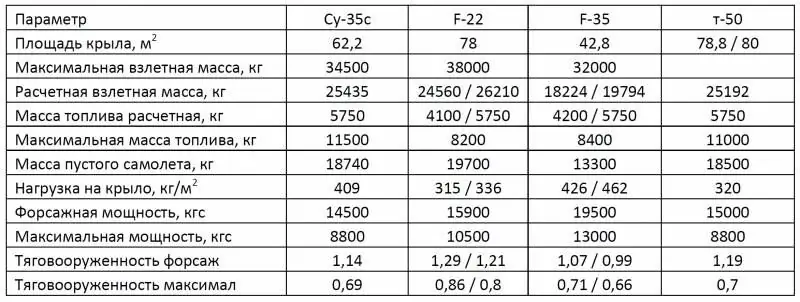
Figure №7
The table in Figure 7 clearly shows the main advantages of the fifth generation aircraft over the fourth. The gap in wing loading and thrust-to-weight ratio is much more significant than that of the F-15 and Su-27. The potential for energy and an increase in Nyp in the fifth generation is much higher. One of the problems of modern aviation - multifunctionality, also affected the Su-35s. If it looks good with the thrust-to-weight ratio at the afterburner, then the load on the wing is inferior even to the Su-27. This clearly shows that the design of the airframe of the fourth generation aircraft cannot, taking into account the modernization, reach the indicators of the fifth.
The aerodynamics of the F-22 should be noted. There is no official data on aerodynamic quality, however, according to the manufacturer, it is higher than that of the F-15c, the fuselage has an integral layout, the wing load is even less than that of the Eagle.
The engines should be noted separately. Since only the Raptor has engines of the fifth generation, this is especially noticeable in the thrust-to-weight ratio at the “maximum” mode. The specific flow rate at the "afterburner" mode, as a rule, is more than twice the flow rate at the "maximum" mode. The engine operating time at "afterburner" is significantly limited by the aircraft fuel reserves. For example, the Su-27 on "afterburner" eats more than 800 kg of kerosene per minute, therefore, an aircraft with a better thrust-to-weight ratio at "maximum" will have advantages in thrust for a much longer time. That is why Izd 117s is not a fifth generation engine, and neither the Su-35s nor the T-50 have advantages in terms of thrust-to-weight ratio over the F-22. Consequently, for the T-50, the developed fifth-generation engine "type 30" is very important.
Where from all of the above is it still possible to apply the deflected thrust vector? To do this, refer to the graph in Figure 8. These data were obtained for the horizontal maneuver of the Su-27 and F-15c fighters. Unfortunately, similar data for the Su-35s are not yet publicly available. Pay attention to the boundaries of the steady turn for heights of 200 m and 3000 m. Along the ordinate, we can see that in the range of 800-900 km / h for the indicated heights, the highest angular velocity is achieved, which is 15 and 21 deg / s, respectively. It is limited only by the overload of the aircraft in the range from 7, 5 to 9. It is this speed that is considered the most advantageous for conducting close air combat, since the angular position of the aircraft in space changes as quickly as possible. Returning to the fifth generation engines, an aircraft with a higher thrust-to-weight ratio and capable of supersonic movement without the use of afterburner gains an energy advantage, since it can use up the speed to climb until it falls into the range most advantageous for the BVB.

Figure №8
If we extrapolate the graph in Figure 8 on the Su-35s with a deflected thrust vector, how can the situation be changed? The answer is perfectly visible from the graph - no way! Since the boundary in the limiting angle of attack (αadd) is much higher than the strength limit of the aircraft. Those. aerodynamic controls are not fully utilized.
Consider the horizontal maneuver graph for heights of 5000-7000 m, shown in Figure 9. The highest angular speed is 10-12 deg / s, and is achieved in the speed range 900-1000 km / h. It is pleasant to note that it is in this range that the Su-27 and Su-35s have decisive advantages. However, these heights are not the most advantageous for the BVB, due to the drop in angular velocities. How can the deflected thrust vector help us in this case? The answer is perfectly visible from the graph - no way! Since the boundary in the limiting angle of attack (αadd) is much higher than the strength limit of the aircraft.
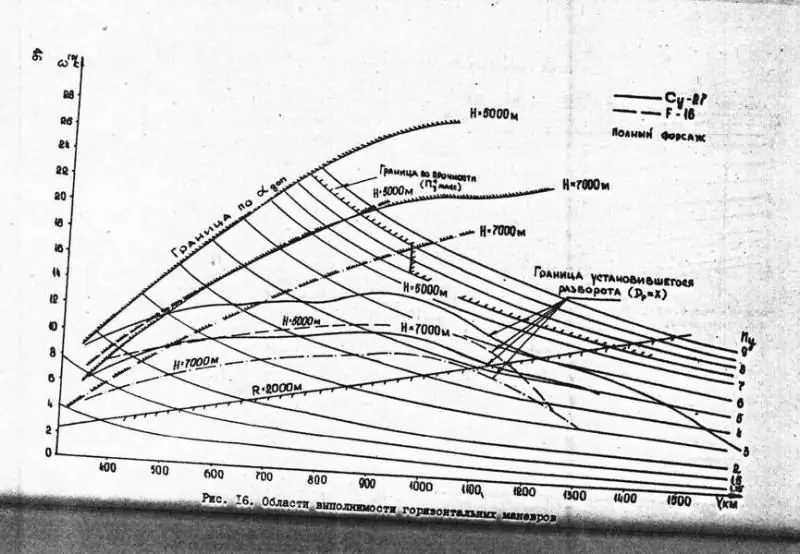
Figure №9
So where can the advantage of the deflected thrust vector be realized? At heights above the most advantageous, and at speeds below the optimum for the BVB. At the same time, deeply beyond the boundaries of the established reversal, i.e. with a forced turn, in which the energy of the aircraft is already consumed. Consequently, OVT is applicable only in special cases and with a supply of energy. Such modes are not so popular in BVB, but, of course, it is better when there is a possibility of vector deviation.
Now let's turn a little to history. During the Red Flag exercises, the F-22 constantly won victories over the fourth generation aircraft. There are only isolated cases of loss. He never met Su-27/30/35 at Red Flag (at least there is no such data). However, the Su-30MKI took part in the Red Flag. Competition reports for 2008 are available online. Of course, the Su-30MKI had an advantage over American vehicles, like the Su-27 (but by no means due to the OVT and not overwhelming). From the reports, we can see that the Su-30MKI on the Red Flag showed a maximum angular velocity in the region of 22 deg / s (most likely at speeds in the region of 800 km / h, see the graph), in turn, the F-15c entered the angular speed of 21 degrees / sec (similar speeds). It is curious that the F-22 showed an angular velocity of 28 deg / s during the same exercises. Now we understand how this can be explained. First, the overload in certain modes of the F-22 is not limited to 7, but is 9 (see Airplane Flight Manual for the Su-27 and F-15). Secondly, due to the lower wing loading and higher thrust-to-weight ratio, the boundaries of the steady turn in our graphs for the F-22 will shift upward.
Separately, it should be noted the unique aerobatics that can be demonstrated by the Su-35s. Are they so applicable in close air combat? With the use of a deflected thrust vector, such figures as "Florova Chakra" or "Pancakes" are performed. What do these figures have in common? They are performed at low speeds in order to get into operational overload, far from the most profitable in the BVB. The plane abruptly changes its position relative to the center of mass, since the velocity vector, although it shifts, does not change dramatically. The angular position in space remains unchanged! What is the difference between a rocket or a radar station that the plane is spinning on its axis? Absolutely none, while he also loses his flight energy. Perhaps with such somersaults we can return fire at the enemy? Here it is important to understand that before launching the rocket, the aircraft needs to lock onto the target, after which the pilot must give “consent” by pressing the “enter” button, after which the data is transmitted to the rocket and the launch is carried out. How long will it take? Obviously more than fractions of a second, which are spent with "pancakes" or "chakra", or something else. Moreover, all this is also at obviously losing speeds, and with a loss of energy. But it is possible to launch short-range missiles with thermal heads without capture. At the same time, we hope that the missile's seeker itself will capture the target. Consequently, the direction of the attacker's velocity vector should approximately coincide with the enemy's vector, otherwise the missile, by inertia received from the carrier, will leave the zone of possible capture by its seeker. One problem is that this condition is not met, since the velocity vector does not change dramatically with such aerobatics.
Consider Pugachev's cobra. To carry it out, it is necessary to turn off the automatics, which is already a controversial condition for air combat. At a minimum, the qualifications of combat pilots are significantly lower than that of aerobatic aces, and even this must be done with jewelry in extremely stressful conditions. But this is the lesser of evils. Cobra is performed at altitudes in the region of 1000 m and speeds in the range of 500 km / h. Those. the plane should initially be at speeds lower than those recommended for the BVB! Consequently, he cannot reach them until the enemy loses the same amount of energy, so as not to lose his tactical advantage. After the execution of the "cobra" the speed of the aircraft falls within the limits of 300 km / h (instant energy loss!) And is in the range of the minimum evolutionary. Consequently, "Drying" must go into a dive to gain speed, while the enemy not only retains the advantage in speed, but also in height.
However, can such a maneuver provide the necessary benefits? There is an opinion that with such braking we can let the opponent go ahead. Firstly, the Su-35s already has the ability to air braking without the need to turn off the automation. Secondly, as is known from the formula for the energy of flight, it is necessary to slow down by climbing, and not in some other way. Thirdly, in modern combat, what should the opponent do close to the tail, without attacking? Seeing in front of you "Drying", performing "cobra", how much easier will it be to aim at the increased area of the enemy? Fourth, as we said above, it will not work to capture the target with such a maneuver, and a missile launched without capture will go into the milk of the resulting inertia. Such an event is shown schematically in Figure 17. Fifthly, I would like to ask again how the enemy got so close without being attacked earlier, and why “Cobra” when it is possible to make “Gorka” while conserving energy?

Figure №10
In fact, the answer to many questions about aerobatics is extremely simple. Demonstration performances and shows have nothing to do with real techniques in close air combat, since they are performed in flight modes that are obviously not applicable in BVB.
On this, everyone must conclude for himself how much the aircraft of the 4 ++ generation is able to withstand the aircraft of the fifth generation.
In the third part, we will talk in more detail about the F-35 and T-50 in comparison with competitors.






